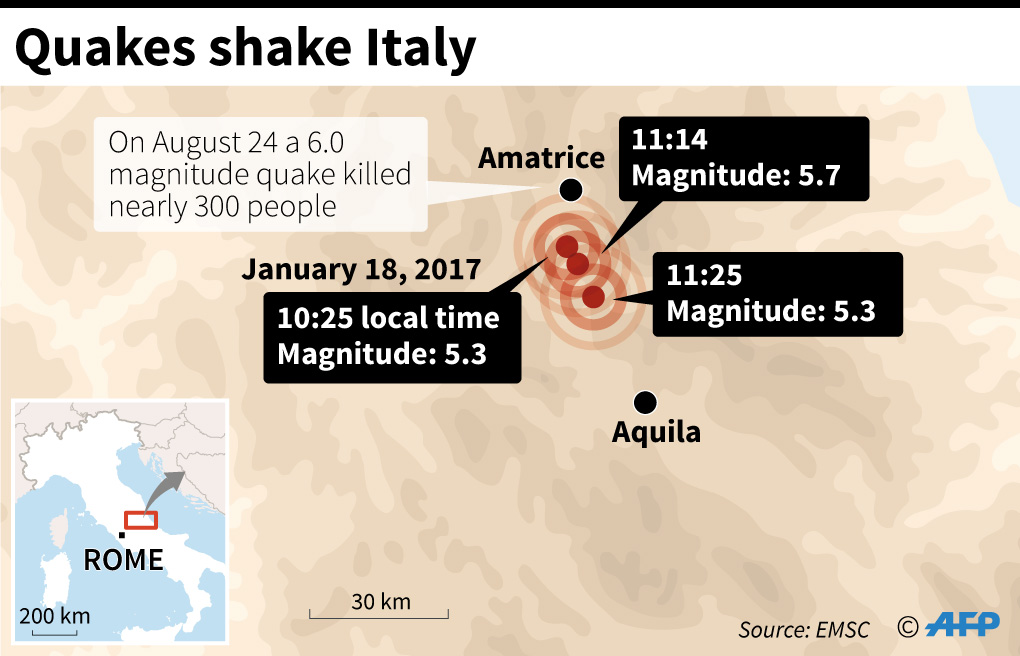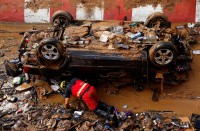
By Angus Mackinnon
ROME, Italy (AFP)– Three earthquakes hit central Italy Wednesday in a seismic triple-punch that brought fresh terror to a snowbound mountainous area still reeling from deadly quakes last year.
The epicentres were all close to the town of Amatrice, where nearly 300 people died in an earthquake in August.
There were no reports of casualties in the three hours after Wednesday’s first shock struck at 10:25 am (0925 GMT).
Monitors put its strength at between 5.1 and 5.3 magnitude. A second, 50 minutes later, was measured at 5.7 by the European Mediterranean Seismological Centre (EMSC) and 5.4 by Italy’s INGV. Both monitors noted the third, minutes later, at 5.3.
The Italian Red Cross said dozens of people were trapped by the snow in their homes and that it had received reports of building collapses in hamlets near Amatrice.
“Happily there have been no victims,” Prime Minister Paolo Gentiloni said at a press conference in Berlin. He said the army’s presence in the affected area would be stepped up.
The tremors were felt across the Abruzzo, Lazio and Marche regions and powerfully enough in Rome, over 100 kilometres (60 miles) away to send some panicked parents scrambling to schools to collect their children.
Centuries-old papal palaces in the capital showcased the mastery of their Renaissance architects by swaying gently to absorb the tremors.
Train services on some mainlines and the Rome underground were briefly suspended but resumed after safety checks.
Some schools in Rome and all those open in the quake zones were evacuated.
Residents of the city of Aquila, where over 300 people died in a 2009 earthquake, rushed into the snow-covered streets in scenes of panic but the mayor said there had been no building collapses there.
– Belltower collapses –
In Amatrice, the belltower of the 15th Century Church of Sant’Agostino crumbled. It had been badly damaged by the first of the earthquakes which struck the mountainous centre of the country between August and October last year.
Most of those who died in that 6.0 magnitude were in Amatrice, a beauty spot which was packed with holiday makers at the height of the summer season.
Two further quakes rattled the region in October, with the most powerful measuring 6.5 magnitude.
The latest quake came in the wake of 36 hours of continuous snowfall in Amatrice.
Avalanche warnings were issued across a region that has a number of ski resorts and a highest peak, Gran Sasso, at 2,912 metres (9,554 feet).
Amatrice mayor Sergio Pirozzi cursed his town’s bad luck.
“I don’t know if we did something bad. That’s what I have been asking since yesterday. We have got up to two metres of snow and now another earthquake. What can I say? I have no words.”
Stefano Petrucci, mayor of nearby Accumoli, described the situation as “dramatic.”
“The roads are unpassable because of the snow and we have hardly any trucks available to clear them, some of them are broken down. We can’t fight a war with bows and arrows.”
– A vulnerable country –
As a result of last year’s quakes many residents have been evacuated to temporary accommodation outside the earthquake-prone zone.
The last of 2016’s major quakes, on October 30, was the most powerful since a 6.9 magnitude one struck near Naples in southern Italy in 1980, leaving 3,000 people dead.
Italy has long been accustomed to dealing with earthquakes and the Amatrice disaster led to questions being asked as to why so many buildings had not been upgraded to ensure they could resist tremors.
Much of Italy’s land mass and some of its surrounding waters are prone to seismic activity with the highest risk concentrated along its mountainous central spine.
Italy straddles the Eurasian and African tectonic plates, making it vulnerable when they move.
The worst disaster of the 20th century was in 1908 when an estimated 95,000 died in tidal waves following a quake in the sea between mainland Italy and Sicily.
am/txw
© 1994-2017 Agence France-Presse








